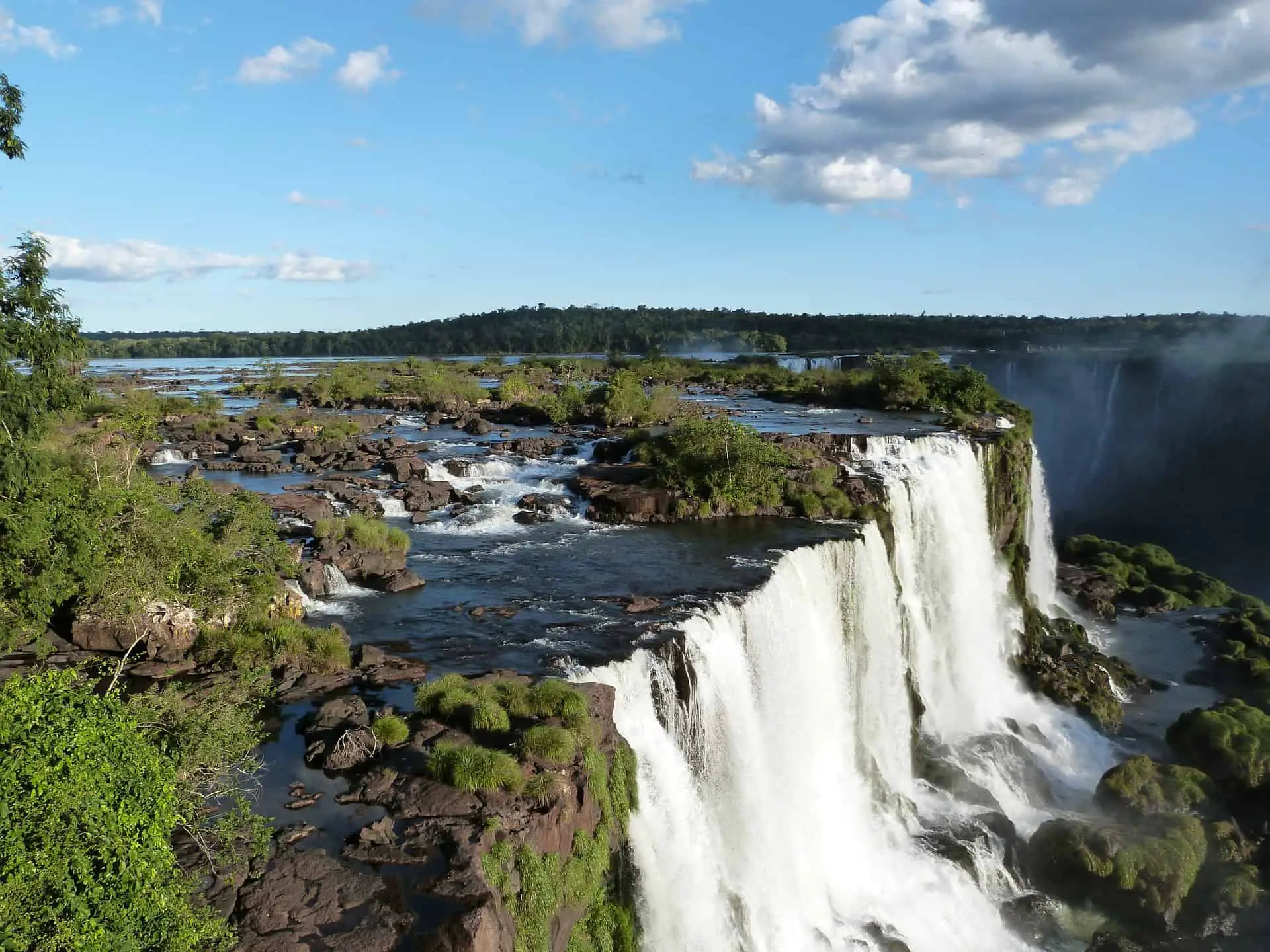Table of Contents
Located deep in the Lieber State Recreation Area, Cataract Falls beckons a bevy of hikers and sightseers every year.
*This post may contain affiliate links. As an Amazon Associate we earn from qualifying purchases.
It’s one of Indiana’s most beautiful sights, but also one of its lesser known.
For those who are curious about visiting the majestic waterfall, but aren’t sure what to expect, you can rest easy. This blog covers everything you need to know about the Cataract Falls area, as well as other natural attractions across Indiana.

Just How Tall is Cataract Falls?
Coming in at a whopping 86 feet, Cataract Falls is the largest waterfall in Indiana by volume. This is partly due to the fact that it’s made up of a cascade of falls, some larger than others.
While it’s the largest waterfall, it isn’t the tallest, as its upper falls are around 20 feet and the lower falls are about 18 feet. The award for tallest waterfall in Indiana belongs to Williamsport Falls, which gets up to 90 feet.
Cataract Falls, created by two pre-glacial breakneck ridges from the Illinoisan glacial period, empty into the Cagles Mill Lake, which is 1,400 acres.
For those hoping to get the best view of the waterfall, there is a 140-foot bridge along the upper portion of the falls. This bridge was built in 1876, but wasn’t open to pedestrians until 1988. In 1995, the bridge was officially restored, so you don’t have to worry about stepping on a loose board and falling through the floor. The waterfall is best enjoyed from dry land.
If you’re not sure if Cataract Falls sounds like a good time, you should know it has a 4.5 out of 5 rating on TripAdvisor. Reviewers specifically mention its peaceful setting, scenic beauty, and the fact that you can see everything in about 20 minutes.
How are the Trails Around Cataract Falls?

What good are beautiful waterfalls if you can’t see them? That’s what trails are for. Not only do you get a good work-out, but you’re rewarded with unforgettable sights and sounds.
Cataract Falls is inside the Lieber State Recreation Area, which is a scenic park lined with a number of hiking trails, for maximum maneuverability. One of these takes you right up close to the waterfall and through the bridge that traverses the upper portion of the falls. This is going to be your ideal position for admiring the waterfall.
If your legs aren’t what they used to be and hiking sounds like more trouble than it’s worth, there’s good news – boat access is provided to Cagles Mill Lake and a nearby campground.
In addition to the falls, the area is also home to an Aquatic Center, which is open during the Summer.
This Aquatic Center includes a pool, water bubblers, and a spiral water slide. For those who enjoy looking at water more than being in it, there’s also a volleyball court and a playground. This is perfect for hikers whose children might not be as enthralled by the scenic marvels as you are, so they can have their fun while you have yours.
What Should You Know Before Embarking Upon a Trail?

Hiking on trails can be fun and is often the best way to truly experience an outdoor area, but it’s important to keep certain things in mind before taking a trail.
As with most outdoor activities, hiking should be approached with as much caution as excitement. Here are 4 great tips to help you make the most of your trip:
1. Know the Area
First, it’s important to know the area where you’re hiking. Make sure to have a map of the trail, which will not only help you keep tabs on your location, but it will also let you know about any nearby points of interests, such as bathrooms or campgrounds.
You should also be aware of weather conditions and any difficult areas. Don’t become overly reliant on your cellphone for information, because in the wilderness, your internet won’t be reliable and you could always run out of battery.
2. Be Physically Fit
You should also make sure you’re physically in shape enough to embark upon a trail.
Even though you’re only walking, hiking does require a certain level of endurance and leg strength. The last thing you want is to get a third of the way through a trail, only to come to the realization that you’re not going to make it the rest of the way and need to turn back.
For those who aren’t sure, some trails also offer horseback rides.
3. Four Legs are Better than Two
Some will insist that less experienced hikers should always bring a buddy. Not only are two heads better than one, but four legs are often better than two. The more hikers that are on a trail together, the more insurance you have regarding each other’s safety.
This might be a bitter pill to swallow if you’re looking to embark on a trail for solitude and to be with nature, but safety should always be most important. If you’re alone on a trail and you sprain your ankle, the remaining hike is going to be rough.
4. Stock Up on the Essentials
Even the most experienced of hikers rely heavily on their apparel. Perhaps, the most important piece of the hiker’s wardrobe are the boots, which get the brunt of the wear and tear.
You won’t need any heavy-duty, mountain boots. Instead, you’ll want to wear lightweight boots that offer strength and protection, but also maneuverability. While this may seem obvious, it’s extremely important they’re the right size, otherwise they could cause pain after extended use.
Cosmopolitan’s Sarah Wexler even suggests forsaking cotton clothing, due to its inability to brave certain weather conditions.
In addition to your clothing, you’ll also want to make sure you have plenty of sun screen and insect repellent.
Bring as much food and water as you think you’ll need, then bring a little more. It’s better to have too much food, rather than too little.
You’ll also want to make sure you have a flashlight, first aid kit, lighter and a knife, because you should be prepared for any situation, however unlikely.
Where are the Other Trails in Indiana?

Now that you’ve thoroughly explored Cataract Falls and the surrounding trails, you’re probably ready for more. That’s good, because Indiana is filled with natural wonders.
Below are our top 3 picks to explore after you’ve taken on Cataract Falls:
1. Hoosier National Forest
Hoosier National Forest is one of the richest natural areas of Indiana. Located less than two hours from Cataract Falls, the Hoosier National Forest is home to the Charles C. Deam Wilderness, which encompasses almost 13,000 acres of the National Forest.
Within this area, there are 37.3 miles of trails, which can be used for hiking or horseback riding, except for one hike-only trail, the Sycamore Trail. The Sycamore Trail is ideal for those looking for the most authentic experience in the wilderness, as it’s almost 5 miles long and will engulf hikers in the solitude of the forest.
2. O’Bannon Woods State Park
Located just East of Hoosier National Forest and nestled up to the Ohio River, the O’Bannon Woods State Park is 2,000 acres of forest.
The trails here include the Rocky Ridge Bike and Hike Trail, the Tulip Valley Trail, and the CCC Ghost Trail.
These and others will take you to many of the area’s most fascinating sites, including the Wyandotte Caves, which have only recently reopened after being closed to the public for seven years. These are limestone caves on the Ohio River that exhibit human activity going back 10,000 years.
3. Shades State Park
Bring your favorite pair of shades to Shades State Park. You’ll need them when you’re hiking one of their 11 trails, which don’t have dedicated names but are, instead, marked numerically.
Trail 1 might be the most interesting trail, as it begins at the Devil’s Punchbowl and will take hikers to the Silver Cascade waterfalls.
If you’re wondering what the Devil’s Punchbowl is – and you know you are – it’s a moss-covered chasm that’s made of fragile, sandstone slopes. It’s not quite as dangerous or exciting as its name suggest, but maybe that’s for the best.
There Plenty of Nature to Experience in Indiana
Cataract Falls is only the beginning when it comes to Indiana’s wealth of outdoor experiences.
After visiting the largest waterfall in the state and spending time at the nearby trails, head south to Hoosier National Forest, then maybe take a short trip to O’Bannon Woods State Park, or Shades State Park.
There’s far more to do than is possible during a single vacation, so you’re definitely going to want to schedule plenty of trips to the area with your family.
But if you want to be sure you return from your vacation, make the recommended preparations before venturing out on the trails, especially if you’re a beginner. Trails aren’t as fun when you’re lost and hungry. It doesn’t take an expert to know that.

